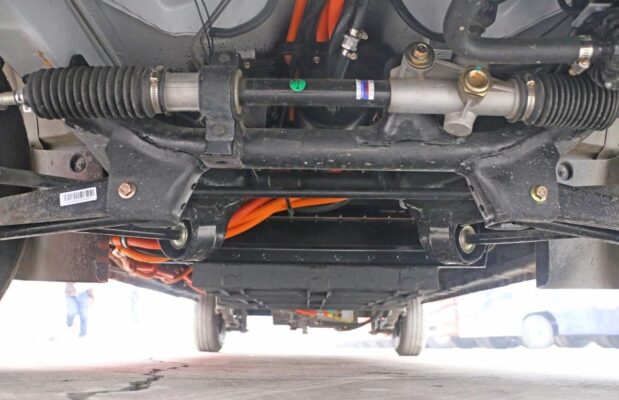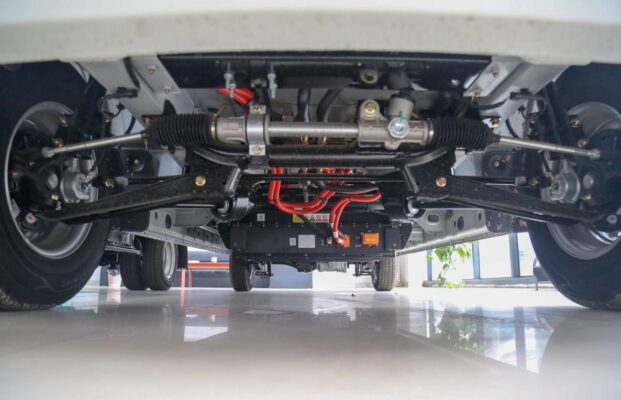Electric Truck Knowledge
Fault Diagnosis of DC-DC Circuit for Pure Electric Vehicles
Posted on by Electric Trucks
- Overview of DC-DC
On-board power supply equipment is an essential prerequisite for the proper functioning of automotive electrical equipment. In traditional vehicles, the main power supply sources are the battery and the generator driven by the internal combustion engine. Gayunpaman, pure electric vehicles do not incorporate internal combustion engines. Instead, they are equipped with rechargeable power batteries to supply high voltage electricity for the entire vehicle, serving as the energy source to sustain the vehicle’s normal operation. Since a significant number of electronic components and control systems within the vehicle utilize a 12V power supply, there necessarily exists a device capable of charging the battery to guarantee an adequate power supply for the vehicle. This device is known as DC-DC, or the DC power conversion module. Through the utilization of the DC-DC DC power conversion module, the voltage of over 300 volts from the power battery can be transformed into a 14V DC constant voltage power supply for vehicle usage. It exhibits characteristics such as high efficiency, a compact size, and the ability to withstand harsh working environments.
Let’s delve deeper into the significance of the DC-DC module. In a pure electric vehicle, the efficient conversion and distribution of power are crucial for the seamless operation of various systems and components. The DC-DC module plays a pivotal role in bridging the gap between the high-voltage power source and the low-voltage requirements of numerous onboard devices. Its high efficiency ensures minimal power losses during the conversion process, contributing to overall energy conservation and maximizing the vehicle’s driving range.

- Working Principle of DC-DC
The DC-DC DC power conversion module is commonly encountered in pure electric vehicles and is typically located in the front engine compartment. When the pure electric vehicle is powered on in the ON position or awakened for charging and powered on, the power battery initiates the high-voltage system pre-charging process. Once this pre-charging process is successfully completed, the awakened VCU (Vehicle Controller Unit) vehicle controller transmits the enable signal to the DC-DC DC power conversion module. Upon receiving this enable signal, the DC-DC DC power conversion module commences its operation. It utilizes the transformed high-voltage direct current to charge the low-voltage battery and provide power to the multitude of electronic components and control systems within the vehicle.
The high-voltage input range of the DC-DC DC power conversion module spans from DC290-420V, the low-voltage enable input range is DC9-14V, and the output voltage is consistently 14V. The commonly employed cooling method for this module is air cooling. The methodology to determine whether the DC-DC DC power conversion module is functioning properly is as follows: Firstly, ensure that the vehicle harness is in a normal connected state. Position the vehicle key in the OFF position, disconnect all electrical appliances, and extract the key. Employ a specialized multimeter voltage range to measure the voltage of the low-voltage battery and record the measurement. Secondly, place the vehicle key in the ON position and once again utilize a specialized multimeter voltage range to measure the voltage of the low-voltage battery. The voltage measured at this juncture represents the output voltage of the DC-DC. If the normal output voltage of the DC-DC lies within the range of 13.2V – 13.5V (or 13.5V – 14V), it can be adjudged that the DC-DC DC power conversion module is operating normally. It is important to note that any unclosed electrical equipment on the vehicle can potentially influence the measurement outcome. Therefore, it is imperative to ensure that all electrical equipment on the vehicle is closed prior to conducting the measurement.

- Fault Diagnosis of DC-DC Circuit
As a DC-to-DC conversion device, the common faults of DC-DC are manifested in its non-functioning. Given that its failure can lead to numerous other malfunctions, the fault diagnosis and maintenance of DC-DC assume particular significance. When it has been determined, through the inspection of the battery before and after power-on, that the DC-DC is not operating normally, the fault inspection should adhere to a sequence from the simplest to the most complex. Firstly, read the fault code via the diagnostic instrument. Subsequently, detect each signal of the DC-DC low-voltage end signal line. Next, examine the input and output of DC-DC. Finally, verify whether the DC-DC assembly is damaged.
In accordance with the maintenance manual, upon completing the safety protection and adhering to the norms for the maintenance operation of new energy vehicles. Firstly, read the fault code through the diagnostic instrument. Once the fault code has been identified, proceed to detect each signal of the low-voltage end signal line of the DC-DC. The common low-voltage end signal lines of pure electric vehicles encompass the power supply terminal, the enable signal terminal, and the ground terminal. Prior to the detection, it is essential to first confirm the integrity of the connector, whether the pins are displaced, and if the connector connection is normal.
Check the DC-DC power supply: Disconnect the low-voltage connector and employ a multimeter in the DC voltage range to measure. There should be a 12V battery voltage between the power supply pin and the negative pole of the battery. In the event that there is no voltage, verify whether the fuse of the low-voltage power supply end of the DC-DC in the front engine compartment fuse box is blown. If the fuse is intact, inspect whether the fuse of the power supply section and the pin of the power supply end of the connector are conducting.

Check the DC-DC negative pole: Disconnect the low-voltage connector and utilize a multimeter in the ohm range to measure whether the ground terminal pin is conducting with the vehicle body ground. If it is not conducting, troubleshoot the harness and any pin displacements.
Check the DC-DC enable signal: Disconnect the low-voltage connector and use a multimeter in the DC voltage range to measure. There should be a 12V voltage between the enable signal pin and the negative pole of the battery. If there is no voltage, employ a multimeter in the ohm range to measure whether the enable signal pin is conducting with the corresponding pin of the vehicle controller.
Then, proceed to detect the high-voltage input of the DC-DC. The steps for detecting the fuse are as follows: Firstly, turn the vehicle key to the off position, remove the negative wiring terminal of the battery, remove the low-voltage end harness plug, then remove the DC high-voltage connector, and subsequently open the PDU box to confirm the integrity of the high-voltage fuse. Select the resistance range of the multimeter. The red and black test leads of the multimeter should be pointed respectively to the two ends of the fuse. If the resistance value is less than 10 ohms, the fuse is intact.
DC-DC low-voltage output detection. Before the detection, it is necessary to first confirm whether the positive and negative output harness and connector are intact, the connection is sound, and there are no phenomena such as looseness and short circuit. The DC-DC output detection method involves: Remove the positive output of the DC-DC. Connect the red test lead to the positive output terminal of the DC-DC, and the black test lead to the negative pole of the battery. Turn the key to the ON state, and the normal voltage should be 12-16V after maintaining the ON state for at least 15 seconds.

- Conclusion
Through a systematic detection process, it has been identified that the faults of the DC-DC DC power conversion module of pure electric vehicles are commonly manifested in three scenarios:
Firstly, the DC-DC low-voltage signal fault encompasses the power supply, grounding, and enable signal at the low-voltage end. Certain models will output multiple sets of signals to monitor the working status of the DC-DC. If present, they also require concurrent verification.
Secondly, the DC-DC high-voltage input fault is predominantly attributed to the damage of the DC-DC fuse.
Thirdly, the DC-DC low-voltage output fault is commonly encountered in connection line faults. This article has elaborated in detail on fault identification, fault verification, fault diagnosis concepts, and fault detection, providing a diagnostic foundation for the fault handling of the DC-DC DC power conversion module circuit system of pure electric vehicles.
Sa pagtatapos, the accurate diagnosis and prompt resolution of faults in the DC-DC circuit of pure electric vehicles are crucial for ensuring the reliable operation and performance of these vehicles. A comprehensive understanding of the working principles, common fault manifestations, and effective diagnostic methods enables technicians and maintenance personnel to efficiently address issues and restore the normal functionality of the power conversion module, thereby enhancing the overall reliability and safety of pure electric vehicle systems.